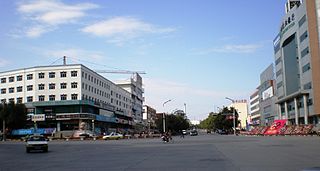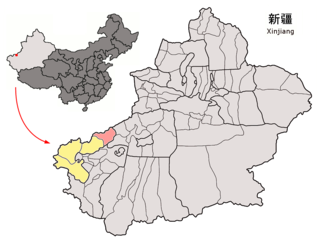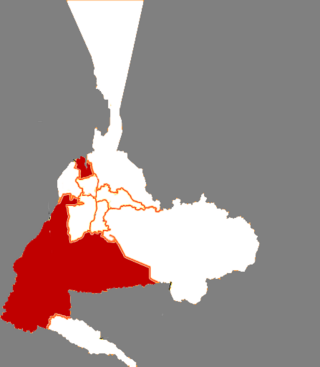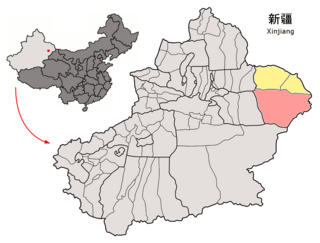
Changji is a county-level city situated about 40 km (25 mi) west of the regional capital, Ürümqi in Northern Xinjiang, China and has about 390,000 inhabitants. It is the seat of Changji Hui Autonomous Prefecture. At the northeast corner of the modern city are the walls and other archaeological remains of the Tang dynasty city, usually referred to as Ancient Changji.

Bole, also known by its Mongolian name Bortala, is a county-level city in Xinjiang, China. It is the seat of Bortala Mongol Autonomous Prefecture, which borders Kazakhstan. The city covers an area of 7,517 square kilometres (2,902 sq mi) and has a total population of 270,000 as of 2015. The Northern Xinjiang Railway runs through the city, as do highways to Ürümqi.

Usu as the official romanized name and transliterated from Mongolian, also known as Wusu, is a county-level city with more than 100,000 residents in Xinjiang, China. It is a part of Tacheng Prefecture of Ili Kazakh Autonomous Prefecture. Oil production is a major part of the economy while the county is an oasis in the Dzungarian Basin. Wusu lies between the major cities of Bole and Shihezi in Northern Xinjiang and west of Ürümqi and Kuitun, south of Karamay.

Tacheng, also known as Tarbagatay, Chuguchak or Qoqek, is a county-level city and the administrative seat of Tacheng Prefecture, in northern Ili Kazakh Autonomous Prefecture, Xinjiang. The Chinese name "Tacheng" is an abbreviation of "Tarbagatay City", a reference to the Tarbagatay Mountains. Tacheng is located in the Dzungarian Basin, some 10 km (6.2 mi) from the Chinese border with Kazakhstan. For a long time it has been a major center for trade with Central Asia because it is an agricultural hub. Its industries include food processing, textiles, and utilities.

Wujiaqu is a county-level city in the northern part of Xinjiang Uyghur Autonomous Region, China, about 40 kilometres (25 mi) north of Ürümqi.

Fukang is a county-level city in Xinjiang Uygur Autonomous Region, China. Its area is 11,726 km2 (4,527 sq mi) and its population in 2007 was reported as approximately 1.5 million. Fukang is located in Northern Xinjiang in Changji Hui Autonomous Prefecture, north of Ürümqi.

Alashankou is a border city in Bortala Mongol Autonomous Prefecture, Xinjiang Uyghur Autonomous Region, China. It is a port of entry by both railroad and highway from Kazakhstan as part of the Eurasian Land Bridge.

Akqi County is a county in Xinjiang Uygur Autonomous Region, China. It is under the administration of the Kizilsu Kyrgyz Autonomous Prefecture. The county has a town and five townships, six communities and 25 villages under its jurisdiction in 2018, its county seat is Akqi Town. The county has a population of about 46,000 with main ethnic groups of Kyrgyz, Han and Uyghur peoples.

Hejing County is located in the central-southern part of the Tian Shan mountains of Xinjiang, in the north-west of Bayingolin Mongol Autonomous Prefecture. The northernmost county-level division of Bayingolin, it borders Ürümqi City to the north, from which it is 190 km (120 mi) as the crow flies, and Korla City to the south, which is 80 km (50 mi) away. It borders 15 cities and counties and is the most bordered county in the world.

Yanqi Hui Autonomous County is an autonomous county in the Xinjiang Uyghur Autonomous Region and is under the administration of the Bayin'gholin Mongol Autonomous Prefecture. It has an area of 2,429 km2 (938 sq mi). According to the 2002 census, it has a population of 120,000. The Shikshin Buddhist Temple Ruins are located in Yanqi County, about 25–30 km (16–19 mi) southwest of the town of Yanqi.

Qitai County as the official romanized name, also transliterated from Uyghur as Guqung County or Gucheng County, is a county in the Xinjiang Uyghur Autonomous Region of China under the administration of the Changji Hui Autonomous Prefecture. It covers an area of 16,641 square kilometres (6,425 sq mi) and as of the 2002 census had a population of 230,000.

Manas County is a county in the Xinjiang Uyghur Autonomous Region under the administration of the Changji Hui Autonomous Prefecture. It covers an area of 9,174 square kilometres (3,542 sq mi) and as of the 2002 census it had a population of 170,000.

Hutubi County as the official romanized name, also transliterated from Uyghur as Kutubi County, is a county in the Xinjiang Uyghur Autonomous Region and is under the administration of the Changji Hui Autonomous Prefecture. It contains an area of 9,476 km2. According to the 2002 census, it has a population of 210,000.

Jinghe County as the official romanized name, also transliterated from Uyghur as Jing County, is a county of the Xinjiang Uyghur Autonomous Region and is under the administration of the Börtala Mongol Autonomous Prefecture. It contains an area of 11,181 square kilometres (4,317 sq mi). According to the 2002 census, it has a population of 120,000.

Yiwu County as the official romanized name, also transliterated from Uyghur as Aratürük County, is a county in the northeast of the Xinjiang Uyghur Autonomous Region and is under the administration of the Hami City. It contains an area of 19,511 km2 (7,533 sq mi). According to the 2002 census, it has a population of 20,000.

Ürümqi County is a county of Xinjiang Uyghur Autonomous Region, Northwest China, it is under the administration of the prefecture-level city of Ürümqi, the capital of Xinjiang. It contains an area of 4,601 km² and according to the 2002 census has a population of 80,000.

Midong District is one of 7 urban districts of the prefecture-level city of Ürümqi, the capital of Xinjiang Uygur Autonomous Region, Northwest China. Its land area is 3,408 km2 (1,316 sq mi); it has a population of 296,000.
The Manasi River is in the south of Dzungarian Basin, Xinjiang, China.

Yizhou is the central district of the Hami prefecture-level city, in Xinjiang Uyghur Autonomous Region, China. Its population was 472,175 at the end of 2010. It was known as Hami county-level city until February 2016, when it was merged with the Hami Prefecture to form the Hami prefecture-level city and the county-level city was renamed Yizhou District. Xingxingxia (Singsingsia) town is located on the border with Gansu.
The Shihezi Headquarters Farm (石河子总场) is an economic and paramilitary formed unit at regiment-level in Xinjiang Production and Construction Corps (XPCC), that is part of the 8th Division of the XPCC (兵团第八师). The farm is headquartered in Beiqun Town (北泉镇) of Shihezi City, Xinjiang Uygur Autonomous Region, China. It is composed of 23 companies and 11 residential communities. As of 2018, its population was about 8,5000. The Shihezi Headquarters Farm is co-located with Beiquan Town Government.



























